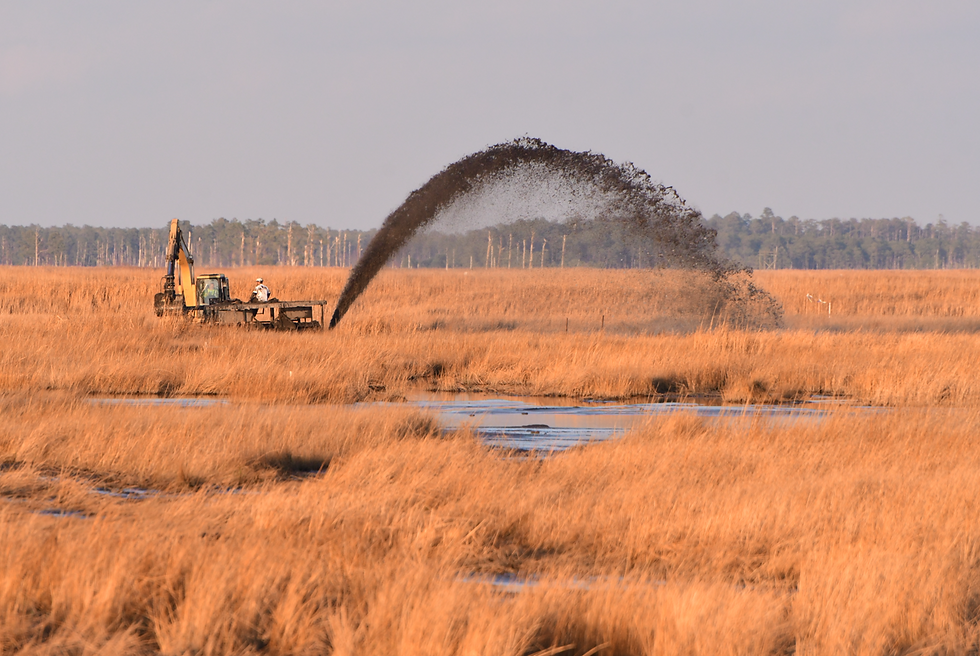All About Marshes: Marsh Threats
- Jared Parks, LSLT Director of Land Programs
- Aug 22, 2024
- 4 min read
Threats to Salt Marshes and Restoration Opportunities
Maryland is often described as “America in miniature” due in large part to the breadth of physiographic regions within the state (5). As one traverses the state from east to west, you begin on the shores of the Atlantic Ocean within the Coastal Plain and then travel through the Piedmont, Blue Ridge, Valley and Ridge, and finally end on the Appalachian Plateau. Each of these regions has very distinct hydrology, geology, and topography that make Maryland one of the most diverse states in the American east. Though climate change is predicted to affect all of these regions over time, the salt marshes characteristic of Maryland’s Coastal Plain are already showing significant signs of degradation. Unlike the four inland regions of the state, the Coastal Plain is very flat. This lack of relief, combined with historic mismanagement, has created more pressing problems in salt marshes than other areas within the Coastal Plain.
Healthy salt marshes are among the most productive systems in the world. The vegetation is fast-growing and produces a huge amount of biomass which helps sustain the marsh. Accretion of soil by plants in a healthy marsh can keep up with sea level rise, especially in areas where human impacts and management have been minimal. Unfortunately, many of Maryland’s salt marshes within the Chesapeake and Coastal bays are not the healthiest. For years, the salt marshes were ditched and altered for mosquito control, navigation, and even some agricultural uses. The intent was to create better drainage within the marshes. It has become increasingly clear, however, that the ditching has had the opposite effect.

Ditched Marsh and “megapools” in Berlin, MD.
Photo credit: Roman Jesian, Maryland Coastal Bays Program
When many of the ditches were dug, the spoils removed were placed along the banks of the new ditch effectively creating a small levee. These levees generally allow water to overflow from the ditch into the marsh, but do not allow the water to easily drain as the tide recedes. Since vegetation in the high marsh zone is only adapted to periodic flooding, it doesn't fare well when continuously submerged in water trapped on the marsh. The vegetation is further stressed when the water evaporates creating high salt concentrations that are above the plants’ tolerance levels. These two stressors will eventually kill the vegetation and cause the marsh to erode from the inside out.
Coupled with global sea level rise and regional land subsidence, Maryland’s marshes are rapidly losing the battle for their continued existence. If nothing is done to address the issues in Maryland’s salt marshes, the marshes will continue to disappear at a rapid rate. Fortunately, there are a couple of practices that can be employed to help alleviate some of the problems.
The first is called “runneling,” a restoration technique that aims to drain areas of ponding from the marsh platform. This practice is fairly inexpensive as it involves using a shovel to create very narrow, shallow drainage channels (runnels) from the ponded areas. A small team of people can do the work without any specialized equipment and cover a lot of ground, quickly.

Runnel at USFWS “Rum Point” pilot project in Berlin, MD.
Photo credit: Dave Curson, Audubon Mid-Atlantic
The other method is known as “beneficial reuse” or “sediment placement” where sediment is sprayed over the degraded marsh to raise the surface. This method is more expensive than runneling and requires a suitable, nearby source of material to be a viable option. Areas where runneling or beneficial reuse are used may also need to be replanted in native vegetation to jumpstart the revegetation process. Restoration of the marsh through sediment placement is most often used in areas where adjacent dredging operations are used to keep waterways open and navigable. Other sources of material, such as spoils from wetland restoration projects, are being sought to expand the areas where this practice can be used.

Sediment Placement at Blackwater National Wildlife Refuge. Photo credit: Middleton Evans
Maryland’s salt marshes are vitally important for a whole host of reasons. These habitats not only protect inland areas from storms and flooding events, but they provide critical habitat for a very unique assemblage of plants and animals that can be found nowhere else. As climate change and sea level rise continue to threaten these ecosystems, restoration efforts such as runneling and beneficial reuse will help extend the life of our marshes, including the most imperiled high marsh. Additionally, efforts to identify and protect the corridors where the marshes can migrate inland as sea level rises, will further extend the ability of these ecosystems to persist into the future.
Marshes for Tomorrow (MfT) is an ambitious project led by Audubon mid-Atlantic and regional partners of the Delmarva Restoration and Conservation Network (DRCN) to identify, protect, and restore at least 25,000 acres of the most important tidal salt marsh habitat on Maryland’s Eastern Shore for Saltmarsh Sparrows. MfT is utilizing the most recent scientific analysis coupled with community input to select the areas to concentrate our efforts. If you would like to learn more about MfT or join one of our upcoming public meetings, please visit the MfT website at https://www.delmarvarcn.org/marshesfortomorrow.

Opmerkingen